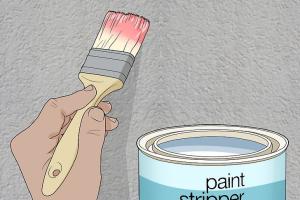Ultimate Guide on How to Remove Paint from Walls: Expert Tips & Techniques

-
Quick Links:
- Introduction
- Types of Paint
- Preparation Steps
- Essential Tools and Supplies
- Manual Removal Techniques
- Chemical Removal Techniques
- Steam Removal Techniques
- Safety Tips
- Case Studies
- Expert Insights
- FAQs
Introduction
Removing paint from walls can be a daunting task, but with the right knowledge and tools, the job can be done efficiently and safely. Whether you’re preparing to repaint or simply want to restore your walls to their original state, this comprehensive guide will walk you through various methods of paint removal, ensuring you choose the best option for your specific situation.Types of Paint
Understanding the type of paint on your walls is crucial for selecting the appropriate removal technique. Here are the most common types:- Latex Paint: Water-based and easy to clean up with soap and water.
- Oil-Based Paint: Requires solvents for removal and can be more challenging to strip.
- Chalk Paint: A popular choice for furniture and decorative pieces, typically easy to remove.
- Enamel Paint: Known for its durability, often requires chemical methods for removal.
Preparation Steps
Before starting the paint removal process, it’s essential to prepare your workspace:- Clear the Area: Move furniture and cover the floor with drop cloths.
- Wear Protective Gear: Use gloves, goggles, and a mask to protect yourself from dust and chemicals.
- Ventilate the Room: Ensure good airflow to avoid inhaling fumes.
Essential Tools and Supplies
Gather the following tools and supplies based on your chosen removal method:Manual Removal
- Scraper or putty knife - Sandpaper or sanding sponge - Wire brushChemical Removal
- Paint stripper - Solvents (like mineral spirits or acetone) - Rags or paper towelsSteam Removal
- Steam wallpaper stripper - Towels for cleanupManual Removal Techniques
Manual methods are usually less toxic and less expensive. Here’s how to do it:Scraping
1. Start at a corner and gently scrape the paint off the wall using a putty knife. 2. Be careful not to damage the underlying surface. 3. Use a sanding sponge to smooth out any rough patches.Sanding
1. Use fine-grit sandpaper to remove stubborn paint spots. 2. Sand in a circular motion and apply even pressure. 3. Clean up any dust with a damp cloth afterward.Chemical Removal Techniques
If manual methods are ineffective, consider chemical solutions. Follow these steps:Using Paint Stripper
1. Apply the paint stripper according to the manufacturer's instructions. 2. Allow it to sit for the recommended time until the paint bubbles. 3. Scrape off the paint with a putty knife.Using Solvents
1. Dampen a cloth with the solvent and test it on a small, inconspicuous area first. 2. Wipe the paint with the cloth until it loosens. 3. Rinse the area with clean water afterward.Steam Removal Techniques
Steam removal is an efficient way to strip paint without chemicals: 1. Heat the steam wallpaper stripper according to the instructions. 2. Hold it against the paint for a few seconds to soften it. 3. Scrape off the softened paint with a putty knife.Safety Tips
- Always work in a well-ventilated area. - Wear appropriate protective clothing, including gloves and goggles. - Dispose of paint waste according to local regulations.Case Studies
Case Study 1: Removing Oil-Based Paint from a Living Room Wall
A homeowner faced the challenge of removing layers of oil-based paint from their living room wall. After testing a small area with a solvent, they opted for a paint stripper, which successfully lifted the paint with minimal damage to the drywall.Case Study 2: Restoring a Vintage Bedroom with Latex Paint
A vintage bedroom needed restoration after years of wear and tear. The owner used manual scraping and sanding methods to reveal the original wall texture, enhancing the room's charm.Expert Insights
According to home improvement experts, choosing the right paint removal method is critical for preserving wall integrity. For example, using a gentle approach on older homes can prevent damaging plaster or wallpaper underneath.FAQs
1. What is the easiest way to remove paint from walls?
The easiest way depends on the paint type. Manual scraping is effective for latex paint, while chemical strippers work better for oil-based paints.2. Can I remove paint without chemicals?
Yes, using manual methods like scraping, sanding, or steam removal can be effective alternatives.3. How do I know if the paint is latex or oil-based?
Perform a simple test with rubbing alcohol; if it softens, it’s latex; if not, it’s likely oil-based.4. Is it safe to use chemical strippers indoors?
It’s recommended to use them in well-ventilated areas and wear protective gear.5. Can I paint over a wall that has had paint removed?
Yes, but ensure the surface is clean, dry, and free of any residue.6. How long does it take to remove paint from walls?
Time varies based on the method; manual methods can take longer than chemical methods.7. What should I do with the removed paint?
Dispose of it according to local regulations regarding hazardous waste.8. Can I hire professionals for paint removal?
Yes, hiring professionals can save time and ensure a safe removal process.9. Are there any eco-friendly paint removers?
Yes, there are several eco-friendly options available in stores that use natural ingredients.10. What is the best way to prepare walls for repainting?
After paint removal, clean the walls thoroughly and repair any damages before repainting.Random Reads